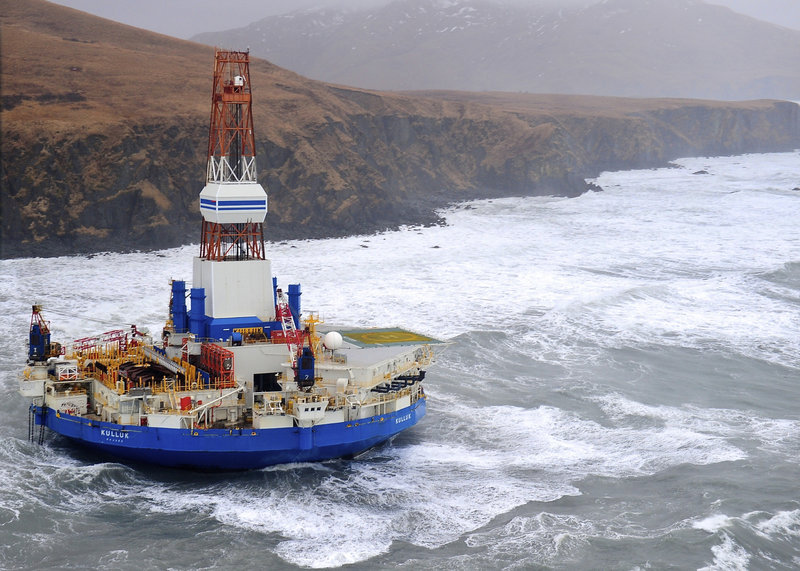ANCHORAGE, Alaska – The grounding of a petroleum drilling ship on a remote Alaska island has refueled the debate over oil exploration in the U.S. Arctic Ocean, where critics for years have said the conditions are too harsh and the stakes too high to allow dangerous industrial development.
The drilling sites are 1,000 miles from Coast Guard resources, and environmentalists argue offshore drilling in the Arctic’s fragile ecosystem is too risky.
So when a Royal Dutch Shell PLC ship went aground on New Year’s Eve on an uninhabited island in the Gulf of Alaska, they pounced – saying the incident foreshadowed what will happen north of the Bering Strait if drilling is allowed.
For oil giant Shell, which leads the way in drilling in the frontier waters of the U.S. Arctic, a spokesman said the grounding will be a learning experience in the company’s years-long effort to draw oil from beneath the ocean floor, which it maintains it can do safely. Though no wells exist there yet, Shell has invested billions of dollars gearing up for drilling in the Beaufort and the Chukchi seas, off Alaska’s north and northwest coast.
The potential bounty is high: The U.S. Geological Survey estimates 26.6 billion barrels of recoverable oil and 130 trillion cubic feet of natural gas exist below Arctic waters.
Environmentalists note the Beaufort and the Chukchi seas are some of the wildest and most remote ecosystems on the planet. They also are among the most fragile, supporting polar bears, the ice seals they feed on, walrus, endangered whales and other marine mammals that Alaska Natives depend on for their subsistence culture.
“The Arctic is just far different than the Gulf of Alaska or even other places on Earth,” said Marilyn Heiman, U.S. Arctic director for the Pew Environment Group.
Royal Dutch Shell PLC in 2008 spent $2.1 billion on Chukchi Sea leases and estimates it has spent a total of nearly $5 billion on drilling efforts there and in the Beaufort.
Shell Alaska spokesman Curtis Smith said the company has a long, successful history of working offshore in Alaska and is confident it can build another multidecade business in the Arctic.
“Our success here is not by accident,” Smith said. “We know how to work in regions like this. Having said that, when flawless execution does not happen, you learn from it, and we will.”
The drill ship that operated in the Beaufort Sea, the Kulluk, a circular barge with a funnel-shape hull and no propulsion system, ran ashore Monday on Sitkalidak Island, near the larger Kodiak Island in the gulf.
The ship had left Dutch Harbor in the Aleutian Islands under tow behind the anchor handler Aiviq on Dec. 22. It was making its way to a Pacific Northwest shipyard for maintenance and upgrades when it ran into a vicious storm.
The tow line snapped Dec. 27. Shell vessels and the Coast Guard reattached tow lines at least four times. High wind and seas that approached 50 feet frustrated efforts to control the rig, and it ran aground on a sand and gravel beach.
Shell, the drill ship operators and transit experts, and the Coast Guard are planning the salvage operation.
The grounding in the North Pacific is not a wellhead blowout in the Arctic, and not a drop of oil has been detected in the water. But environmental groups say it’s a bad sign.
Drill rigs in Arctic waters could be affected by ice any time during the four-month open water season, said Heiman of the Pew Environment Group. The other threats – near hurricane-force winds compounded by cold and darkness – were seen in the grounding, she said.
Send questions/comments to the editors.



Success. Please wait for the page to reload. If the page does not reload within 5 seconds, please refresh the page.
Enter your email and password to access comments.
Hi, to comment on stories you must . This profile is in addition to your subscription and website login.
Already have a commenting profile? .
Invalid username/password.
Please check your email to confirm and complete your registration.
Only subscribers are eligible to post comments. Please subscribe or login first for digital access. Here’s why.
Use the form below to reset your password. When you've submitted your account email, we will send an email with a reset code.